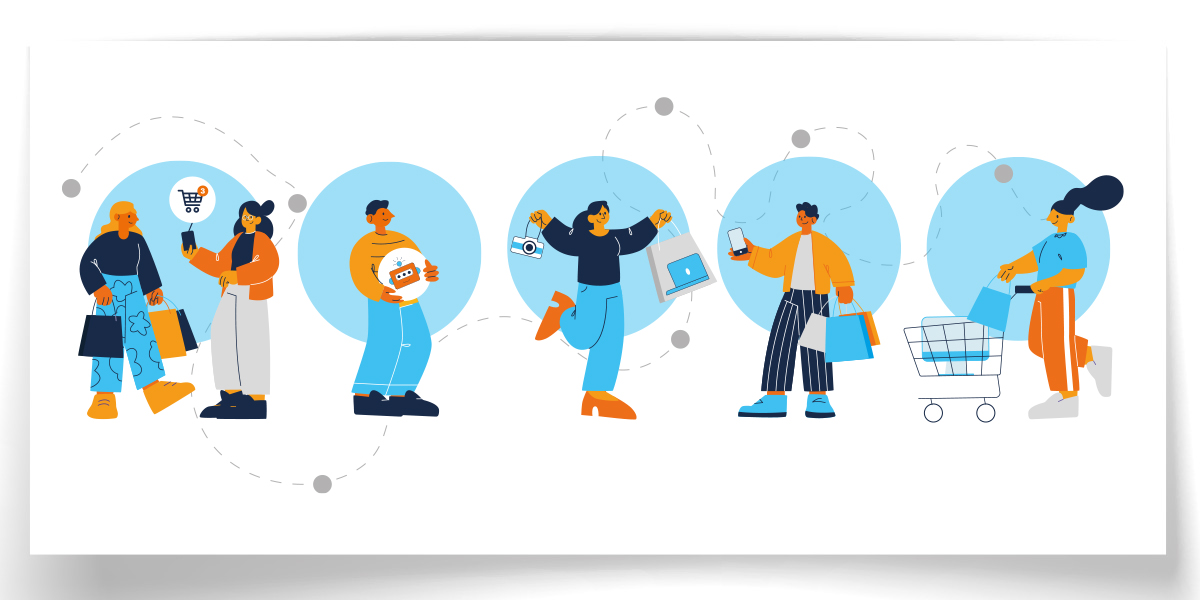It’s no secret that the consumer electronics industry has a big future: the market is expected to reach $602.5bn by the end of 2023. Unlike some other consumer goods categories, electronics technology constantly advances and products are upgraded, so it’s important for retailers to provide all the information shoppers need to make confident buying decisions. If you want to stand out from the competition, providing a seamless customer experience with helpful support is key.
In this blog series, we explore the customer journey through the eyes of customers themselves. Let’s follow one shopper through two different experiences to highlight how guided selling features can be the difference between losing and winning a sale.
Version 1: Too many options, too little information
David is a middle-aged music lover who is looking to upgrade his sound system. He hasn’t replaced his speakers for over seven years, so he’s not sure what’s on the market or what he should buy. He visits his favorite electronic store’s website and clicks on “speakers” in the menu. On the category page, he scrolls through the many filter options but is only able to use a few. After adding in his price range and bluetooth capabilities preference, the list of products is still over 300 options. Feeling a little overwhelmed, he starts to scroll through the products, clicking on a few to see more details. The information provided is short and full of technical jargon that he isn’t familiar with, which makes him more frustrated. After scrolling through the huge list of products for a few more minutes, he decides that he doesn’t know enough about what he needs and leaves the site to do some research on Google.
Version 2: Providing the right support at the right time
Let’s re-imagine David’s experience with guided selling features to support him on his search. He clicks on “speakers” in the menu of the website and lands on a category page with a list of best-sellers at the top. He scans the best-selling speakers for a few seconds but doesn’t click on anything just yet. A chatbot pops up in the corner of the screen and asks: “Looking for new speakers? I can help you find the right sound system for you!” David clicks “yes” and the chatbot proceeds to ask him several questions that help narrow his search: “Do you want speakers for an indoor or outdoor space?” “What is the primary function you’ll be using your speakers for?” “How important is base quality for you?”
After a few more questions, the chatbot presents David with a personalized recommendation for a speaker set in his price range, complete with an explanation as to why it matches his needs. He reads through detailed information on the product page and scrolls down to look at several positive customer reviews, which convinces him to pull the trigger. He receives an email confirming his purchase and a link to the customer service page that he can contact any time if he has any questions.
Connecting the Dots: Insights for Consumer Electronic Shops
In a market like electronics, providing consultation and detailed product information is an important part of the customer experience. Shoppers expect to be given the support they need to make buying decisions, especially when the products they’re buying are high-priced.
David’s shopping experience highlights a few key insights that digital retailers can use to improve customer satisfaction and earn their loyalty.
1. Provide shoppers with a starting point
David’s problem started right away in version 1 when he landed on the category page and was met with hundreds of options. To give visitors a starting point on their search, retailers can provide a “best-sellers” recommendations list at the top of the page like in version 2. That way they don’t get overwhelmed with all the filter options and endless list of products before they even start browsing. Of course, there are also numerous other logics based on which recommendations can be displayed.
2. Offer digital consultations at the right time
In version 2 of David’s speaker search, a chatbot popped up and offered to help him after he was inactive on the category page for a few moments. This was the right moment to intervene: understanding when and where customers need help is the first step in providing support. Retailers that sell products with lots of varying options should consider which categories require guidance and set up a chatbot questionnaire to point their customers in the right direction. Even if they don’t choose to buy the item recommended to them, they’re more likely to stay on the site and trust in a brand’s expertise when given active support.
3. Detailed product pages help seal the deal
Providing personalized recommendations is a great way to earn customer trust, but they’re still going to expect more convincing before making a purchase. David decided to buy his speakers after reading through a detailed description of the product and getting access to several customer reviews. Retailers should make sure that their product information is easy to read and provides the details that customers want to know. Adding in customer reviews directly on the product page also gives them outside advice that they’d otherwise leave the site to find.
Looking for more tips? Check out our white paper on conversion optimization with personalization!
